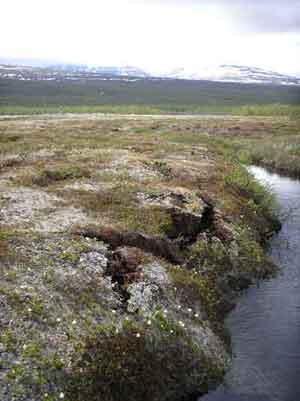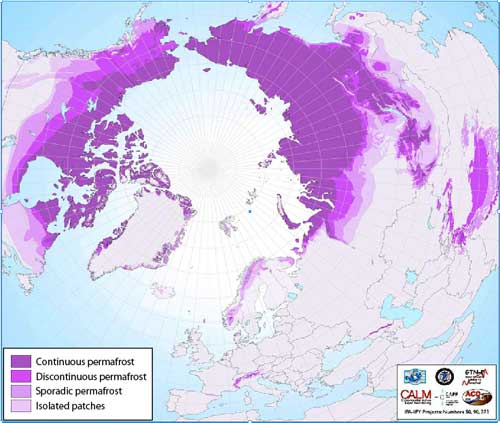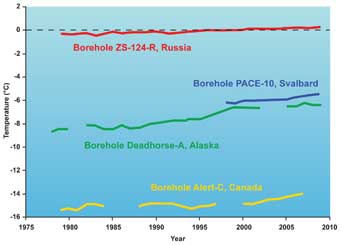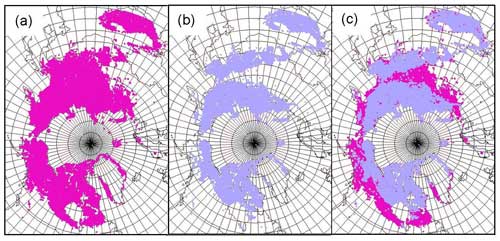
IN THIS ISSUE
Thematic Focus: Climate Change, Ecosystem Management
|
Permafrost refers to places where the ground (soil, rock, organic material, and ice) remains below 0°C for at least two consecutive years. Most permafrost was formed during cold glacial periods; in the past, it has remained throughout warmer interglacial times, including over the past 10 000 years (IPA 2010a). With global warming, however, the store of carbon held in permanently frozen organic matter buried in permafrost could gradually melt, emitting greenhouse gases— including potent methane—into the atmosphere and exacerbating climate change through a positive feedback loop. Already, there are signs that this is happening (Figure 1). Permafrost regions in the Northern Hemisphere cover about a quarter of its land area (23 million km²) and are comprised of zones of continuous permafrost (places where the ground is permanently frozen over 90-100 per cent of the landscape), discontinuous permafrost (50-90 per cent of the area), and sporadic permafrost (0-50 per cent of the area) (Figure 2) (IPA 2010a). |
 |
Full Size Image
|

Full Size Image
Figure 2: Permafrost zones in the Northern Hemisphere Source: IPA 2010a
 |
Permafrost varies in thickness from several metres to 1 000 m or more. The farther north permafrost occurs, the thicker and colder it is. In the subarctic it may be just one or two degrees below the melting point while on the Alaskan Arctic Plain it can be as cold as –10° C and lower (NOAA n.d.). Climatic conditions and ground temperatures are the major factors affecting permafrost thickness and stability. On average, permafrost has warmed by up to 6°C during the 20th century (NSIDC 2008). |
Full Size Image
|
As climate change progresses, the world's northernmost regions—where permafrost is concentrated—are experiencing the largest changes in climate. Over the past several decades, there is evidence of rising permafrost temperatures in lowlands and mountains (IPA 2010a). The Arctic is also being affected (Figure 3). A team of researchers in the James Bay region of Quebec, for example, have found that the permafrost line has retreated northward by about 130 km, with most of the change having occurred in the past 50 years (Thibault and Payette 2009). In another example, continuous permafrost on the North Slope of Alaska has warmed by 2.2–3.9ºC over the last century, leading to the loss of permafrost land, as seen in Figure 4, compiled from Landsat data and topographic maps. Land lost in this study area more than doubled from 1985–2005, compared to the 30-year period from 1955–1985 (Mars and Houseknecht 2007).
Figure 4: Thawing permafrost at Cape Halkett, Alaska

Full Size Image
In this Landsat satellite image of Cape Halkett, Alaska, a landscape of thawing permafrost appears like a section of
white and grey bone, full of openings. Blue and green indicate where open water has increased from 1955 to 2005. Smaller areas
of reddish orange show land gained. Landsat gives us a special vantage point to monitor changes in the landscape over time.
Image credit: Mars/Houseknecht, USGS
Widespread loss of discontinuous permafrost will change hydrologic processes and trigger erosion or subsidence of these ice-rich landscapes, increasing the incidence of natural hazards for people, structures, roads, and communication links (Rekacewicz 2000). In addition, and very importantly, it releases carbon dioxide (CO2) and methane to the atmosphere.
Permafrost soils contain huge amounts of carbon because as they formed, organic matter from vegetation gradually accumulated as the soils froze and decomposition slowed or stopped. Arctic permafrost contains 950 gigatonnes of organic carbon (C) within the first few surface metres of permafrost; by comparison, the atmosphere currently contains about 750 gigatonnes of organic carbon (Walter and others 2009).
When permafrost thaws, decomposing organic matter emits carbon dioxide (CO2) to the atmosphere. When thawing occurs under a lake in the absence of oxygen, it emits methane, which has a warming potential (relative greenhouse effect) that is 23 times stronger than that of CO2, although methane does not persist in the atmosphere for as long as CO2. Thus, permafrost thawing increases the effects of CO2 from fossil-fuel burning and acts as a positive feedback to global warming (permafrost carbon feedback or PCF) that is projected to intensify with further permafrost degradation in the future (Figure 5).
Because of the insulating effects of vegetation, organic material, and snow cover, there is normally a lag between increased ground-surface temperature and the warming of permafrost layers, which varies between decades for thin permafrost and hundreds of thousands of years for thick permafrost. It is thus difficult to predict how quickly permafrost may thaw. Modelling exercises have found that it might disappear altogether in the discontinuous permafrost region (Natural Resources Canada 2007). Figure 6 shows potential future changes to Arctic permafrost extent.
Much uncertainty also exists about how much greenhouse gases will be emitted to the atmosphere over time. In fact, melting permafrost was not factored into reports from the United Nations’ Intergovernmental Panel on Climate Change (IPCC).
What are the findings and implications?
 |
For the first time, researchers have estimated the amount of carbon that could be released to the atmosphere in the future from thawing permafrost and the expected impact on climate change. Their estimates result from calculations using three global climate models based on a scenario of moderate global warming, an emission scenario from the IPCC, and a land-surface model (Schaefer and others 2011). The researchers predict that by 2200, permafrost area will have declined by 29-59 per cent and the active layer (the top permafrost layer that freezes in winter and thaws in summer) will have increased by 53-97cm. This thawing will release a total of about 190 ± 64 gigatonnes of carbon to the atmosphere over that time, an amount the researchers believe is on the low side. |
Full Size Image
|
The increase in atmospheric CO2 concentrations and the associated increase in surface warming will trigger a positive permafrost carbon feedback (PCF) where more warming causes more thawing, which accelerates thawing, which accelerates warming (Figure 5). After the mid-2020s, the Arctic will shift from acting as a carbon sink to a carbon source.
Increasing concentrations of CO2 in the atmosphere between now and 2100 are expected to stimulate plant growth in the tropics, leading to a projected intake of ~160 Gt more carbon by photosynthesis. This carbon sink figures in calculations of the global carbon balance, which is central to projecting climate change. However, the research by Schaefer and others (2011) suggests that by 2100, the release of carbon from thawing permafrost (104 ± 37 Gt) is enough to cancel out much of that carbon sink. This increased CO2 released by permafrost under PCF is not currently figured into most climate projections.
The international community will need to take this new information into account in determining the amount of fossil fuel emission reductions needed to reach target atmospheric CO2 concentrations. The researchers calculate that it will require an additional 14 per cent reduction (Schaefer and others 2011). It is important that science-based studies continue to predict the impacts of permafrost thawing; it will have major consequences for people living in Arctic regions, and will affect the entire world as it exacerbates climate change and its impacts on ecosystems and human well-being.

Full Size Image
Figure 6: This figure shows the mean extent of permafrost in the Arctic, estimated for (a) the years 1990-2000 and (b) the years
2090-2100. In (c), the estimation of loss of permafrost by 2100 is overlaid on estimates for the year 2000. Source: USGS 2009
References
IPA. (2010a). International Permafrost Association. http://ipa.arcticportal.org/resources/what-is-permafrost (Last accessed on February 21, 2011).
IPA. (2010b). Frozen Ground- The News Bulletin of IPA. http://ipa.arcticportal.org/publications/frozen-ground (Last accessed on March 16, 2011).
Mars, J. and Houseknecht, D. (2007). "Quantitative Remote Sensing Study Indicates Doubling of Coastal Erosion Rate in Past 50 Years along a
Segment of the Arctic Coast of Alaska." United States Geological Survey (USGS). http://energy.usgs.gov/flash/AKcoastalErosion.swf (Last accessed on February 24, 2011).
Natural Resources Canada. (2007). Permafrost. 20 December 2007. http://gsc.nrcan.gc.ca/permafrost/climate_e.php (Last accessed on February 21, 2011).
NOAA. (n.d.)"Arctic Change: Land, Permarfrost." http://www.arctic.noaa.gov/detect/land-permafrost.shtml (Last accessed on February 24, 2011).
NSIDC. (2008). National Snow and Ice Data Center: State of the Cryosphere. 2008. http://nsidc.org/sotc/permafrost.html (Last accessed on February 24, 2011).
Rekacewicz, P. (2000). "Change in permafrost temperature in Fairbanks (Alaska)." UNEP/GRID-Arendal Vital Climate Graphics.
http://maps.grida.no/go/graphic/change-in-permafrost-temperature-in-fairbanks-alaska (Last accessed on February 24, 2011).
Schaefer, K., Zhang, T., Bruhwiler, L., Barrett, A. (2011). "Amount and timing of permafrost carbon release in response to climate warming." Tellus, Series B:
Chemical and Physical Meterology, February 2011: Online edition.
Thibault, S. and Payette, S. (2009). "Recent permafrost degradation in bogs of the James Bay area, northern Quebec, Canada." Permafrost and Periglacial
Processes 20, no. 4 (October/December 2009): 383–389.
USGS. (2009). Arctic Now Traps 25 Percent of World’s Carbon -- But That Could Change. http://www.usgs.gov/newsroom/article.asp?ID=2326
(Last accessed on March 16, 2011).
Walter A., Grosse, G., Jones, B. (2009). "Positive and negative feedbacks to climate change associated with methane emissions from arctic
permafrost systems." American Geophysical Union, Fall Meeting. The Smithsonian/NASA Astrophysics Data System, 2009. http://adsabs.harvard.edu/abs/2009AGUFM.B43F..06W.
(Last accessed on February 24, 2011).>
Information is regularly scanned, screened, filtered, carefully edited, and published for
educational purposes. UNEP does not accept any liability or responsibility for the accuracy, completeness, or any other quality of information and
data published or linked to the site. Please read our privacy policy and
disclaimer for further information.
